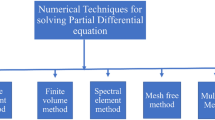Abstract
In this text, we discuss an interpolation (or a collocation) point of view to reproducing kernel methods to approximate solutions to some linear and non-linear functional equations. The proposed method allows us to avoid the usual process of orthogonalization, solving a system of algebraic equations, with a positive defined matrix in the linear case. This also helps us to understand some methods present in the literature on this subject. We include some examples to illustrate the proposed method and an appendix with algorithms implemented in the R language.



Similar content being viewed by others
References
Azarnavid B, Parand K (2018) An iterative reproducing kernel method in Hilbert space for the multi-point boundary value problems. J Comput Appl Math 328:151–163. https://doi.org/10.1016/j.cam.2017.07.015
Du H, Chen Z, Yang T (2021) A meshless method in reproducing kernel space for solving variable-order time fractional advection-diffusion equations on arbitrary domain. Appl Math Lett 2021:116. https://doi.org/10.1016/j.aml.2020.107014
Fasshauer GE (2011) Positive definite kernels: past, present and future. In: Dolomites research notes on approximation, vol 4 (Special Issue on Kernel Functions and Meshless Methods), pp 21– 63. http://www.math.iit.edu/fass/PDKernels.pdf
Ferreira JC, Baquião MC (2019) A least square point of view to reproducing kernel methods to solve functional equations. Appl Math Comput 357:206–221. https://doi.org/10.1016/j.amc.2019.04.008
Ferreira JC, Ferreira EC (2018) On reproducing kernel and applications. Adv Anal 3(1):11–22. https://doi.org/10.22606/aan.2018.31002
Ferreira JC, Menegatto VA (2012) Reproducing properties of differentiable Mercer-like kernels. Math Nach 285(8–9):959–973. https://doi.org/10.1002/mana.201100072
Geng F, Cui M (2007) Solving a nonlinear system of second order boundary value problems. J Math Anal Appl 327(2):1167–1181. https://doi.org/10.1016/j.jmaa.2006.05.011
Geng FZ, Qian SP (2018) An optimal reproducing kernel method for linear nonlocal boundary value problems. Appl Math Lett 77:49–56. https://doi.org/10.1016/j.aml.2017.10.002
Li X, Wu B (2018) A new reproducing kernel collocation method for nonlocal fractional boundary value problems with non-smooth solutions. Appl Math Lett 86:194–199. https://doi.org/10.1016/j.aml.2018.06.035
Li XY, Wu BY (2020) A new kernel functions based approach for solving 1-D interface problems. Appl Math Comput 380:25. https://doi.org/10.1016/j.amc.2020.125276
Minh HQ (2010) Some properties of Gaussian reproducing kernel Hilbert spaces and their implications for function approximation and learning theory. Constr Approx 32:307. https://doi.org/10.1007/s00365-009-9080-0
Shi D, Du H (2021) New reproducing kernel Chebyshev wavelets method for solving a fractional telegraph equation. Comp Appl Math 40:126. https://doi.org/10.1007/s40314-021-01512-8
Vahdati S, Fardi M, Ghasemi M (2018) Option pricing using a computational method based on reproducing kernel. J Comput Appl Math 328:252–266. https://doi.org/10.1016/j.cam.2017.05.032
Wang Y, Chao L (2008) Using reproducing kernel for solving a class of partial differential equation with variable-coefficients. Appl Math Mech-Engl Ed 29:129. https://doi.org/10.1007/s10483-008-0115-y
Wang Y, Chaolu T, Chen Z (2010) Using reproducing kernel for solving a class of singular weakly nonlinear boundary value problems. Int J Comput Math 87(2):367–380. https://doi.org/10.1080/00207160802047640
Wang Y, Pang J, Li Z (2010) Efficient solution of a class of partial integro-differential equation in reproducing kernel space. Int J Comput Math 87(14):3196–3198. https://doi.org/10.1080/00207160902890287
Wang YS, Lijuan CX, Xiaona L (2011) Using reproducing kernel for solving a class of singularly perturbed problems. Comput Math Appl 61(2):421–430. https://doi.org/10.1016/j.camwa.2010.11.019
Yulan W, Chaolu T, Jing P (2009) New algorithm for second-order boundary value problems of integro-differential equation. J Comput Appl Math 229(1):1–6. https://doi.org/10.1016/j.cam.2008.10.007
Acknowledgements
The author would thank referees for their comments and suggestions on their manuscript which have helped to improve the paper.
Author information
Authors and Affiliations
Corresponding author
Ethics declarations
Conflict of interest
The authors declare that they have no conflict of interest.
Additional information
Communicated by Jose Alberto Cuminato.
Publisher's Note
Springer Nature remains neutral with regard to jurisdictional claims in published maps and institutional affiliations.
Appendix A: Complementary information to the numerical examples
Appendix A: Complementary information to the numerical examples
We present the R language implementation of algorithm proposed in Theorem 2.5 adapted to Example 3.1.

We present the R language implementation of algorithm proposed in Theorem 2.5, jointly with Expression 2.5, to the nonlinear Riccati differential equation of Example 3.2. Graphs is produced as in the previous example.

We present the R language implementation of algorithm proposed in Theorem 2.5, jointly with Expression 2.5, to the nonlinear boundary value problem of Example 3.3.
We find the polynomial p(x) by using Lagrange’s interpolation formula.

1.1 A.1 On the reproducing kernel of some subspaces of \(\mathcal {H}_K\)
We include a lemma for the sake of completeness (please see Theorem 3.2 in Azarnavid and Parand (2018) to a particular version of this result).
Lemma A.1
Let \(\mathcal {H}_K\) being a reproducing kernel Hilbert space, with reproducing kernel \(K:X\times X\rightarrow \mathbb {R}\), and
to some \(x_0,x_1,\ldots ,x_n\in X\) and \(\alpha _0,\alpha _1,\ldots ,\alpha _n\in \mathbb {R}\). If \(l(l(K^x))\ne 0\), for all \(x\in X\), then the subspace \(W=\{u\in \mathcal {H}_K:\, l(u)=0\}\) is a reproducing kernel Hilbert space with kernel
Proof
Note that
is in \(\mathcal {H}_K\), and that
does not depend of x.
Now let, \(u\in W\), hence
To finishes, note that
This means that \(K_1^x\in W\), for all \(x\in X\). \(\square \)
Corollary A.2
Let \(\mathcal {H}_K\) being a reproducing kernel Hilbert space, with reproducing kernel \(K:X\times X\rightarrow \mathbb {R}\), and
to some \(x_0,x_1,\ldots ,x_n\in X\) and \(\alpha _{ij}\in \mathbb {R}\), to \(1\le j\le m\). If \(l_j(l_j(K_{j-1}^x))\ne 0\), then the subspace \(W_j=\{u\in W_{j-1}:\, l_j(u)=0\}\) is a reproducing kernel Hilbert space with kernel \(K_j\), where \(W_0=\mathcal {H}_K\) and
Rights and permissions
About this article
Cite this article
Ferreira, J.C. On a collocation point of view to reproducing kernel methods. Comp. Appl. Math. 40, 221 (2021). https://doi.org/10.1007/s40314-021-01612-5
Received:
Revised:
Accepted:
Published:
DOI: https://doi.org/10.1007/s40314-021-01612-5




